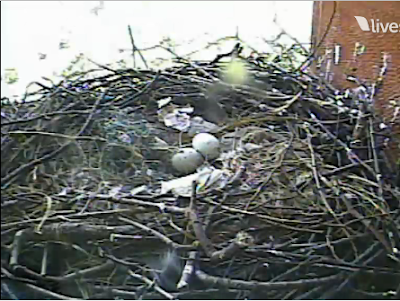Important Answers about the NYU Red-Tailed Hawk nest from John Blakeman
Who is John Blakeman?
John Blakeman of Huron, Ohio, is a life-long student of this species in the wild. I am a licensed Master Falconer, flying a red-tailed hawk. I have conducted a breeding project with this species in the early 19070s, have trapped and banded dozens of red-tailed hawks in Ohio, and have been involved in a number of scientific studies of this species in Ohio and Nevada. I advise principals involved with The Franklin Institute urban hawk nest in Philadelphia, along with those monitoring Pale Male and other red-tailed hawks in Central Park. I am a retired biology teacher and have studied wild red-tails since 1968. I’m as familiar with the biology and natural history of this species as anyone.
Should the band be removed from Violet’s leg?
No, it should not be removed. At the start of incubation this year, Violet’s right leg was clearly very swollen, and she did not have full control of its toes. It was erroneously presumed — by both me and others at the time — that the distal leg swelling was caused by the band, that it was too tight and was pinching off proper circulation. The situation appeared ominous.
However, much has been learned and observed since then. First, the time and location of Violet’s banding has been learned, and this information clearly indicates that there is no present problem that should be addressed.
The hawk, a female (a “formel”), was banded in October 2006, at Delaware Water Gap, just east of the Pocono’s at the junction of New York, Pennsylvania, and New Jersey. Significantly, this was five years ago. If the band were too small, or was pinching into the hawks leg, the bird would have suffered and died many years ago. Because of the length of successful life the hawk has experience since 2006, it is very clear that the band has not been the cause of the observed swelling or reduced toe flexibility. A band can’t be pinching a hawk’s leg for five years. Very clearly, the band was properly applied and was not too small or pinching the tarsus, the leg bone.
In fact, because the band now sits far above the lower junction of the tarsus and the toes, it is clear that it is not pinching the leg; that it was freely able to slide up the leg when it swelled.
Is Violet in pain or discomfort?
Absolutely not. I have watched her for many hours in the last two weeks, and she is clearly in no discomfort, pain or stress. But how can that be known? Red-tailed hawks simply do not engage in any of the following behaviors when in pain or discomfort. Violet has been observed preening frequently and at length, both during the day and at night (with the wonderful night camera images). Preening in the comprehensive manner Violet exhibits doesn’t happen with pain, discomfort, stress, or anxiety. She is altogether well.
But the quintessential expression of peace and mental tranquility, as any experienced falconer will tell, is when the bird “rouses,” lifts her feathers, shakes them violently, and allows them to settle naturally back down onto the body. I’ve seen Violet rouse a number of times, and each time it has been a full, powerful rouse that red-tails do when they are happy and contented. From Violet’s preening and rousing behaviors, she simply is in no discomfort, regardless of the views of those unfamiliar with hawk behaviors.
What DID cause the swelling and toe debility?
Doubtless, Violet has had a swelled lower foot, and she clearly does not have full control of the toes of her right foot. She cannot flex the toes with full speed, strength, or extent. The only explanation for this is that she’s been previously injured while capturing prey. Most probably, she has been bitten by the strong, sharp, and long incisors of a squirrel she attempted to kill. But she is recovered — incompletely, but adequately — from this injury. She sits, stands, and walks on the leg. She has learned that when killing prey she must use her left leg, toes, and talons to make the kill. But for as long as five years she’s managed to live very successfully.
The swelling everyone saw at the start of incubation (now much reduced) almost surely was caused by the winding of plastic thread materials around her leg. These had been picked up and brought to the nest as nest lining materials. In the countryside, such materials are usually leaves, grass strands, and other natural materials. But in the city, these hawks picked up what looked to them to be equivalent materials, the Easter grass clump and some other fibrous materials, some of which got entangled around Violet’s leg, causing the swelling.
But she didn’t like this and was able to remove the strands with her powerful beak. It’s no longer a problem.
Thank you, Mr. Blakeman for your patience in answering our many questions concerning Red-Tailed Hawks, Violet, Bobby and Pip in particular. I look forward to sharing more of this interview in the near future!Saidhbhin




















 Hope you all have a great day watching our little family!
Hope you all have a great day watching our little family!

 Our little Pip is quite the precocious little hawk, that's for sure! Only 12 days old and already trying to feed himself! "If Momma's not going to feed me, then I'm just gonna do it myself! OK, here goes nothing ... tug ... tug ... slurp!!!"
Our little Pip is quite the precocious little hawk, that's for sure! Only 12 days old and already trying to feed himself! "If Momma's not going to feed me, then I'm just gonna do it myself! OK, here goes nothing ... tug ... tug ... slurp!!!"


 Good night!
Good night!

















